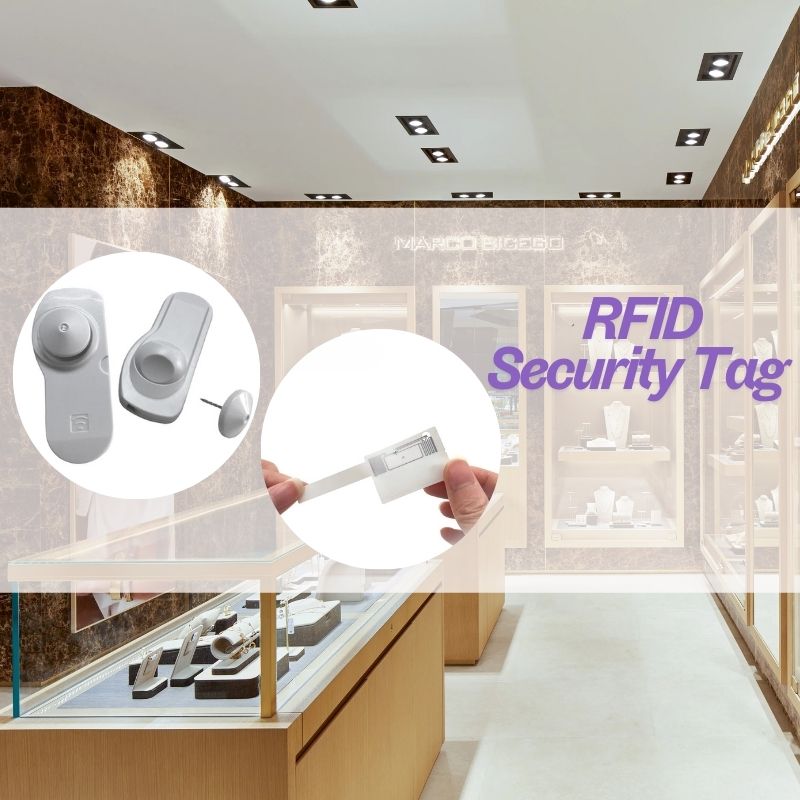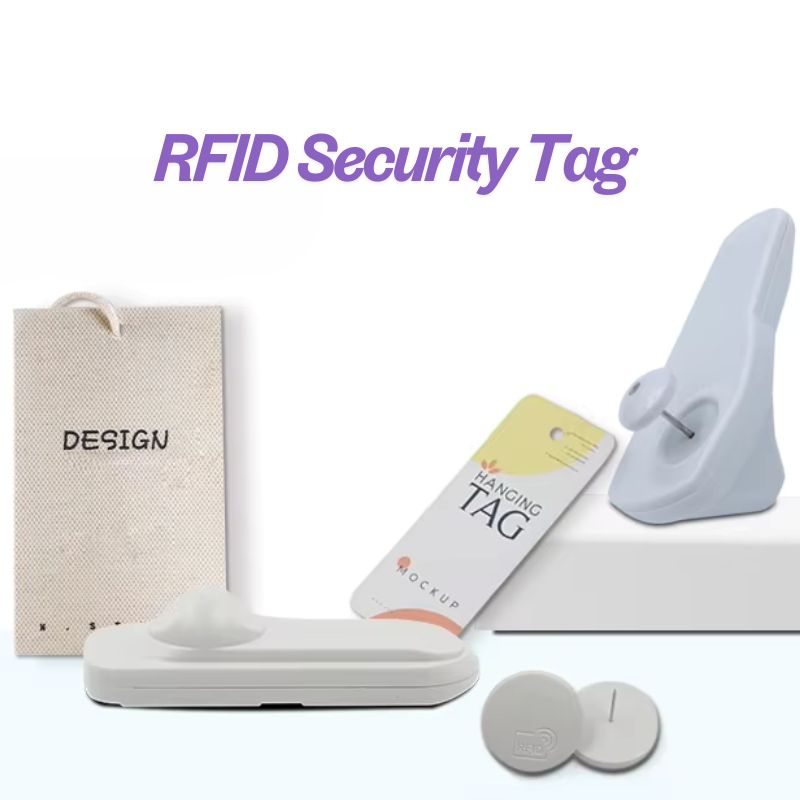
RFID Security Tag: How Anti-Theft RFID Technology Works
Table of Contents
How RFID Security Tags Revolutionize Retail and Prevent Theft
As shoplifting and inventory loss pose significant challenges to retailers, implementing RFID technology offers robust solutions. This article delves into the workings, benefits, and applications of RFID security tags, focusing on how they enhance retail security and inventory control.

What Are RFID Security Tags?
RFID security tags are small devices attached to merchandise to help retailers track inventory and deter theft. These tags communicate with an RFID reader using radio frequency identification technology.
Key Features of RFID Security Tags:
- Microchips to store item data.
- Antennas transmit signals.
- Designed for real-time tracking and theft prevention.
“RFID tags are integral to modern retail security systems, offering more efficient theft prevention than traditional methods.”
How Do RFID Security Tags Work?
RFID security tags use radio waves to transmit item information to an RFID reader, which then communicates with the store’s inventory management system.
Steps in RFID Functionality:
- Tag Activation: The tag interacts with the reader when within range.
- Data Transmission: The tag’s antenna sends data stored in its microchip.
- Alarm Triggering: An alarm sounds to alert store personnel if a tag passes through an exit without being deactivated.
“The integration of RFID systems ensures a seamless approach to tracking and security in retail.”
Benefits of Using RFID Tags in Retail Security
Implementing RFID tags offers numerous advantages, including:
- Improved Theft Prevention: Alerts staff when unauthorized tag movement occurs.
- Enhanced Inventory Control: Tracks stock levels in real-time.
- Streamlined Checkout: Enables quick deactivation at the point of sale.
“Retailers using RFID report significant reductions in theft and improved operational efficiency.”
Applications of RFID Security Tags in Retail Stores
RFID security tags have become a cornerstone of retail security strategies.
Key Applications:
- Inventory Control: Automatically updates stock levels in real time.
- Loss Prevention: Detects unauthorized item movement at store exits.
- Employee Theft Mitigation: Monitors in-store item handling.
Understanding RFID Frequencies
RFID systems operate at different frequency ranges, each suited for specific applications:
- Low Frequency (LF): Operates at 125-134 kHz; suitable for access control and animal tagging.
- High Frequency (HF): Operates at 13.56 MHz; commonly used in contactless payment systems.
- Ultra-High Frequency (UHF): Operates at 860-960 MHz; ideal for supply chain and inventory tracking.
“Choosing the right frequency ensures optimal performance for your RFID application.”
How RFID Prevents Theft and Deters Shoplifters
RFID technology excels at deterring theft through tracking and alarm systems.
Anti-Theft Features:
- Alarms: Triggered when an item exits without deactivation.
- Real-Time Tracking: Monitors item movement throughout the store.
- Deterrence: Visible tags discourage shoplifters from stealing.
“RFID tags are not just reactive—they serve as a proactive measure to deter theft.”
Difference Between RFID and Barcode Technologies
While barcodes have been a staple in retail, RFID offers distinct advantages:
| Feature | RFID | Barcode |
|---|---|---|
| Read Range | Up to 100 meters | Direct line of sight |
| Line of Sight Needed? | No | Yes |
| Durability | Resistant to wear | Easily damaged |
| Data Capacity | High | Limited |
“RFID security tags surpass barcodes in terms of durability, efficiency, and range.”
RFID for Inventory Management and Loss Prevention
Advantages of RFID in Inventory Management:
- Automated Updates: Reduces manual stocktaking errors.
- Real-Time Insights: Enhances decision-making based on current inventory levels.
- Loss Prevention: Tracks high-value items effectively.
“With RFID tags, retailers can track inventory seamlessly and reduce inventory loss.”
Challenges in Adopting RFID Technology
While RFID offers remarkable benefits, retailers face challenges in implementation:
- High Initial Costs: Tags, readers, and integration software can be expensive.
- Signal Interference: Metal and liquids can disrupt signals.
- Deactivation Management: Ensuring all tags are deactivated at checkout.
“Despite these challenges, the long-term benefits of RFID outweigh the initial hurdles.”
Future of RFID Security Systems in Retail
The future of RFID security systems is promising, with innovations aimed at enhancing efficiency and sustainability.
Trends to Watch:
- Integration with IoT: Real-time tracking across multiple locations.
- Eco-Friendly Tags: Recyclable materials for reduced environmental impact.
- AI-Powered Insights: Data analysis for inventory and security optimization.
“As RFID technology evolves, it will continue to revolutionize retail security and operations.”
FAQs on RFID Security Tags

How do RFID security tags work?
RFID tags transmit data to a reader via radio waves, which triggers an alarm if the tag exits without deactivation.
What are the benefits of using RFID tags in retail?
They improve inventory management, deter theft, and enhance retail security through real-time tracking.
How does RFID differ from barcode technology?
RFID doesn’t require a direct line of sight, has a longer read range, and stores more data than barcodes.
What challenges do retailers face when implementing RFID?
High initial costs, signal interference, and deactivation management are common obstacles.
What is the future of RFID in retail security?
Innovations like IoT integration and AI-powered insights will drive the next wave of RFID advancements.
Comments
Hot Products

What Is RFID Waste Management
Imagine a city where every trash bin speaks — not literally — but through a tiny chip that tells the system when it’s full, when it’s emptied, and where it went. That’s what RFID waste management is doing today.

What are Bolt Seals and their Applications? | Complete Guide
In global trade and logistics, bolt seals play a crucial role in ensuring cargo security and compliance. These small but powerful devices are designed to lock shipping containers, trailers, and cargo doors with a tamper-evident mechanism.

What is an RFID Card Protector? Benefits, Use Cases, and Buying Guide
RFID technology (Radio Frequency Identification) is everywhere: in your credit cards, ID badges, transit passes, hotel room keys, and more. It offers speed and convenience, but it also opens the door to a new kind of digital theft called “skimming.” That’s where an RFID card protector comes in.

RFID Wristbands for Events: Bulk Buying Guide for Organizers
RFID wristbands for events are becoming the go-to solution for organizers who need faster entry, fraud prevention, and cashless payments at concerts, festivals, and sports venues. Unlike paper tickets or QR codes, these smart wristbands use embedded chips to streamline access, secure transactions, and improve the guest experience.

How RFID Tag on Windscreen Improves Vehicle Access Control and Toll Systems
In today’s fast-paced world, vehicle identification needs to be quick, secure, and contactless. An RFID Tag on the Windscreen provides exactly that — a reliable way to manage toll collection, parking, and gated access without stopping vehicles.

The Benefits of RFID Linen Tags in Commercial Laundry
Managing laundry in hospitals, hotels, or large laundry services is a big job. Each day, thousands of sheets, towels, and uniforms are washed, sorted, and sent back out. But problems like lost linens, sorting mistakes, and manual counting can cost companies a lot of money. For example, mid-sized hotels can lose over $200,000 each year from missing linens.
That’s where RFID Linen Tags come in.
Tags
RELATED BLOGS

What Is RFID Waste Management
Imagine a city where every trash bin speaks — not literally — but through a tiny chip that tells the system when it’s full, when it’s emptied, and where it went. That’s what RFID waste management is doing today.

What are Bolt Seals and their Applications? | Complete Guide
In global trade and logistics, bolt seals play a crucial role in ensuring cargo security and compliance. These small but powerful devices are designed to lock shipping containers, trailers, and cargo doors with a tamper-evident mechanism.

What is an RFID Card Protector? Benefits, Use Cases, and Buying Guide
RFID technology (Radio Frequency Identification) is everywhere: in your credit cards, ID badges, transit passes, hotel room keys, and more. It offers speed and convenience, but it also opens the door to a new kind of digital theft called “skimming.” That’s where an RFID card protector comes in.




